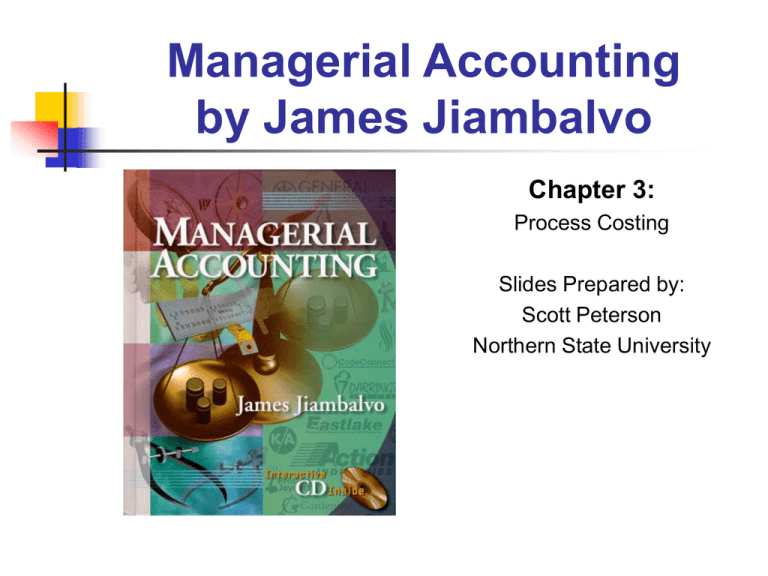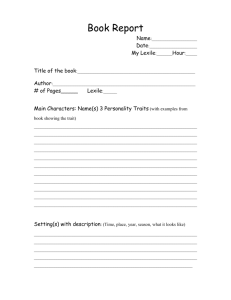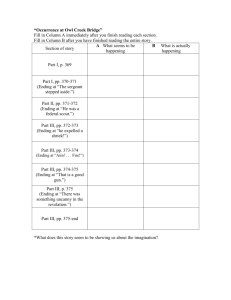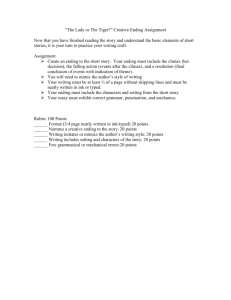
Managerial Accounting
by James Jiambalvo
Chapter 3:
Process Costing
Slides Prepared by:
Scott Peterson
Northern State University
Chapter 3: Process Costing
Chapter Themes:
Inventories are still very
important.
Think about how costs
can be attached to large
numbers of
homogeneous products.
Compare and contrast
Job-Order and Process
Cost systems.
Learning Objectives:
1.
2.
3.
4.
5.
Describe how products flow
through departments and how
costs flow through accounts.
Discuss the concept of an
equivalent unit.
Calculate the cost per equivalent
unit.
Calculate the cost of goods
completed and the ending Work in
Process balance in a processing
department.
Describe a production cost report.
Product Cost Flows
Just as a product passes
through several departments
prior to completion, costs
flow through several
accounts before the product
is recorded in finished goods.
Related Learning Objectives:
1.
2.
3.
4.
5.
Describe how products flow
through departments and how
costs flow through accounts.
Discuss the concept of an
equivalent unit.
Calculate the cost per equivalent
unit.
Calculate the cost of goods
completed and the ending Work in
Process balance in a processing
department.
Describe a production cost report.
Product Flows Through
Departments
Products typically flow
through two or more
departments. Materials, labor
and overhead are added in
each department. Material is
often added at the beginning
of the process. Labor and
Overhead are often grouped
together and added uniformly
throughout the process.
Recall that Labor and
Overhead are referred to as
conversion costs.
Related Learning Objectives:
1.
2.
3.
4.
5.
Describe how products flow
through departments and how
costs flow through accounts.
Discuss the concept of an
equivalent unit.
Calculate the cost per equivalent
unit.
Calculate the cost of goods
completed and the ending Work in
Process balance in a processing
department.
Describe a production cost report.
Cost Flows Through Accounts
In addition to materials, labor
and overhead, a processing
department may have a cost
called transferred-in cost.
This cost is incurred in one
department and then
transferred to the next. And it
is treated like any other
manufacturing cost (material,
labor, overhead) with respect
to that department.
Related Learning Objectives:
1.
2.
3.
4.
5.
Describe how products flow
through departments and how
costs flow through accounts.
Discuss the concept of an
equivalent unit.
Calculate the cost per equivalent
unit.
Calculate the cost of goods
completed and the ending Work in
Process balance in a processing
department.
Describe a production cost report.
Calculating Unit Cost
Process Costing is
essentially a system of
averaging. Specifically,
manufacturing costs incurred
during a specific time period
are divided by a number
called equivalent units to
calculate an average unit
cost.
Related Learning Objectives:
1.
2.
3.
4.
5.
Describe how products flow
through departments and how
costs flow through accounts.
Discuss the concept of an
equivalent unit.
Calculate the cost per equivalent
unit.
Calculate the cost of goods
completed and the ending Work in
Process balance in a processing
department.
Describe a production cost report.
Equivalent Units
In calculating unit cost, it is
necessary to compute
equivalent units. When
partially completed units are
converted to whole units they
are referred to as equivalent
units. A good analogy is the
concept of a full-time
equivalent (FTE) employee. 6
half-time (20 hours per week)
employees make 3 full-time
equivalents.
Related Learning Objectives:
1.
2.
3.
4.
5.
Describe how products flow
through departments and how
costs flow through accounts.
Discuss the concept of an
equivalent unit.
Calculate the cost per equivalent
unit.
Calculate the cost of goods
completed and the ending Work in
Process balance in a processing
department.
Describe a production cost report.
Cost Per Equivalent Unit
The average unit cost in a
process costing system is
referred to as a cost per
equivalent unit. The formula
is as follows: Cost per
equivalent unit = (Cost in
beginning WIP + Cost
incurred in current
period)/(Units completed +
Equivalent units in ending
WIP).
Related Learning Objectives:
1.
2.
3.
4.
5.
Describe how products flow
through departments and how
costs flow through accounts.
Discuss the concept of an
equivalent unit.
Calculate the cost per
equivalent unit.
Calculate the cost of goods
completed and the ending Work in
Process balance in a processing
department.
Describe a production cost report.
Calculating and Applying Cost per
Equivalent Unit: Mixing Department
Example
See if you can calculate cost
per equivalent unit based on
the following information in
the Mixing Department.
Unit Information:
Beginning WIP 10,000
gallons, 80% complete with
respect to labor and
overhead. 70,000 gallons
started and 60,000 completed.
Ending WIP 20,000 gallons
50% complete.
Related Learning Objectives:
1.
2.
3.
4.
5.
Describe how products flow
through departments and how
costs flow through accounts.
Discuss the concept of an
equivalent unit.
Calculate the cost per equivalent
unit.
Calculate the cost of goods
completed and the ending Work
in Process balance in a
processing department.
Describe a production cost report.
More
Calculating and Applying Cost per
Equivalent Unit: Mixing Department
Example
Cost Information:
Beginning WIP $18,000
materials, $7,800 labor and
$23,400 overhead. During the
month $142,000 of material
cost and $62,200 of labor cost
was added. Overhead is
applied at a predetermined
rate of $3 per dollar of labor
or $186,600. See the next
slide for the solution.
Related Learning Objectives:
1.
2.
3.
4.
5.
Describe how products flow
through departments and how
costs flow through accounts.
Discuss the concept of an
equivalent unit.
Calculate the cost per equivalent
unit.
Calculate the cost of goods
completed and the ending Work
in Process balance in a
processing department.
Describe a production cost report.
More
Calculating and Applying Cost per
Equivalent Unit: Mixing Department
Example (solution)
$6 per unit.
Related Learning Objectives:
1.
2.
3.
4.
5.
Describe how products flow
through departments and how
costs flow through accounts.
Discuss the concept of an
equivalent unit.
Calculate the cost per equivalent
unit.
Calculate the cost of goods
completed and the ending Work
in Process balance in a
processing department.
Describe a production cost report.
Production Cost Report
A Production Cost Report is
an end-of-the-month report
for a process costing system
that provides a reconciliation
of units and a reconciliation
of costs as well as details of
the cost per equivalent unit
calculations.
Related Learning Objectives:
1.
2.
3.
4.
5.
Describe how products flow
through departments and how
costs flow through accounts.
Discuss the concept of an
equivalent unit.
Calculate the cost per equivalent
unit.
Calculate the cost of goods
completed and the ending Work in
Process balance in a processing
department.
Describe a production cost
report.
Reconciliation of Units
Assuming no units are lost
due to shrinkage, the number
of units in beginning WIP
plus the number of units
started should be equal to the
number of units completed
plus the number of units left
in ending WIP. [Inventory is
very important.]
Related Learning Objectives:
1.
2.
3.
4.
5.
Describe how products flow
through departments and how
costs flow through accounts.
Discuss the concept of an
equivalent unit.
Calculate the cost per equivalent
unit.
Calculate the cost of goods
completed and the ending Work in
Process balance in a processing
department.
Describe a production cost
report.
Reconciliation of Costs
For each period, the total cost
that must be accounted for is
the sum of the costs in
beginning WIP plus costs
incurred during the period.
This sum must be equal to
the costs transferred out plus
whatever cost is left over in
ending WIP.
Related Learning Objectives:
1.
2.
3.
4.
5.
Describe how products flow
through departments and how
costs flow through accounts.
Discuss the concept of an
equivalent unit.
Calculate the cost per equivalent
unit.
Calculate the cost of goods
completed and the ending Work in
Process balance in a processing
department.
Describe a production cost
report.
Basic Steps in Process
Costing: A Summary
1.
2.
3.
4.
Account for the number
of equivalent units.
Calculate the cost per
equivalent unit for
material, labor and
overhead.
Assign cost to items
completed and items in
ending WIP.
Account for the amount
of product cost.
Related Learning Objectives:
1.
2.
3.
4.
5.
Describe how products flow
through departments and how
costs flow through accounts.
Discuss the concept of an
equivalent unit.
Calculate the cost per
equivalent unit.
Calculate the cost of goods
completed and the ending Work
in Process balance in a
processing department.
Describe a production cost
report.
Copyright
© 2001 John Wiley & Sons, Inc. All rights reserved. Reproduction or
translation of this work beyond that permitted in Section 117 of the 1976
United States Copyright Act without the express written permission of the
copyright owner is unlawful. Request for further information should be
addressed to the Permissions Department, John Wiley & Sons, Inc. The
purchaser may make back-up copies for his/her own use only and not for
distribution or resale. The Publisher assumes no responsibility for errors,
omissions, or damages, caused by the use of these programs or from the
use of the information contained herein.




